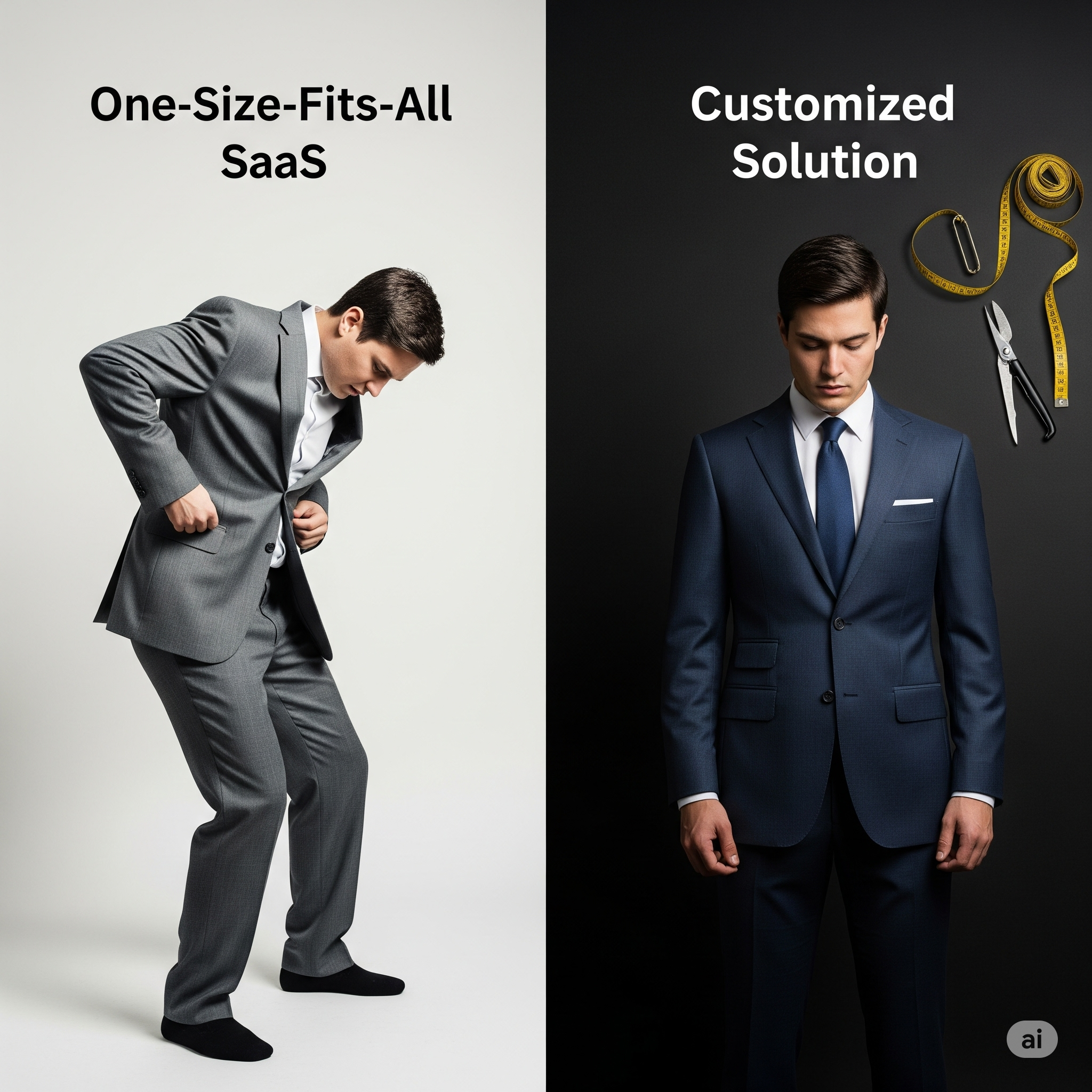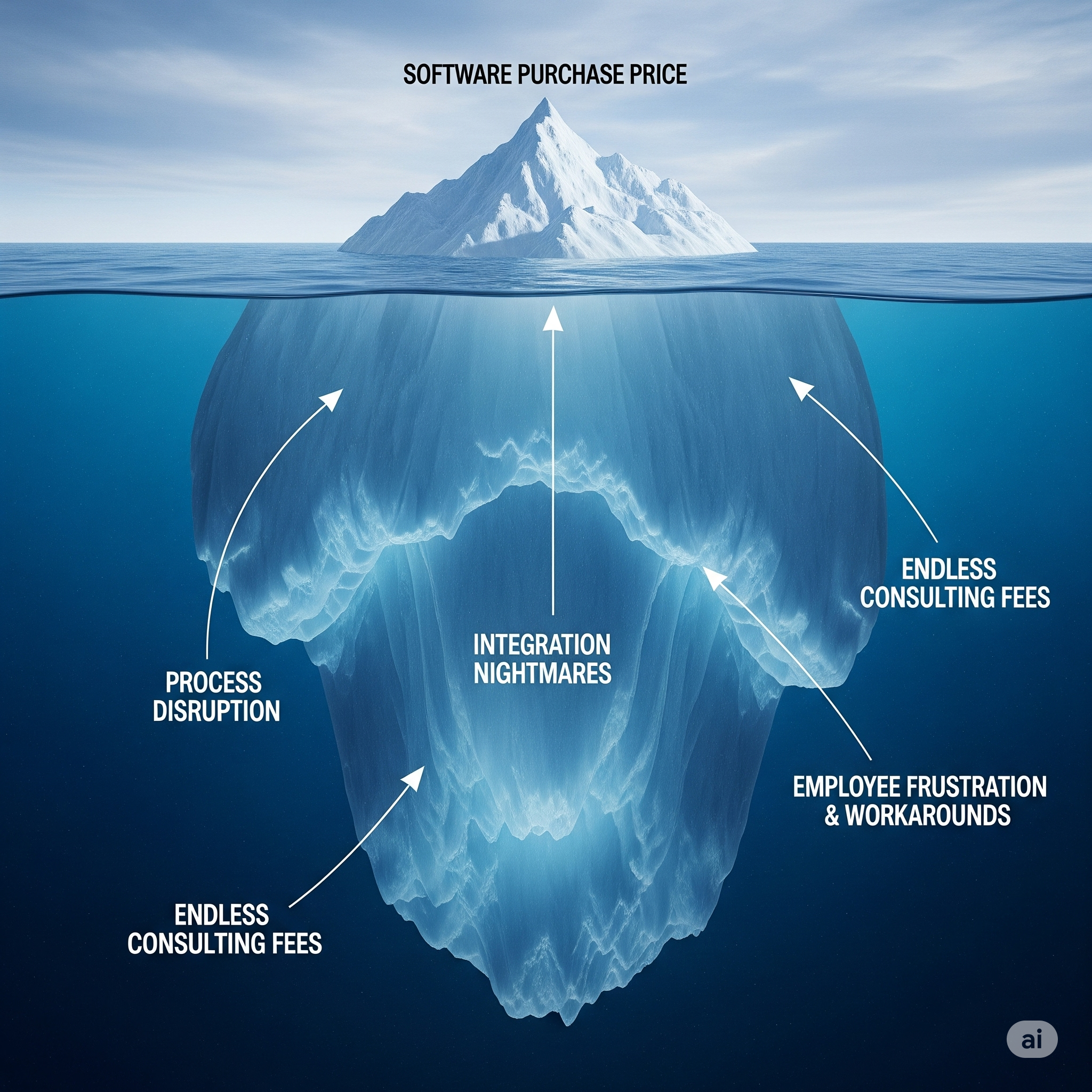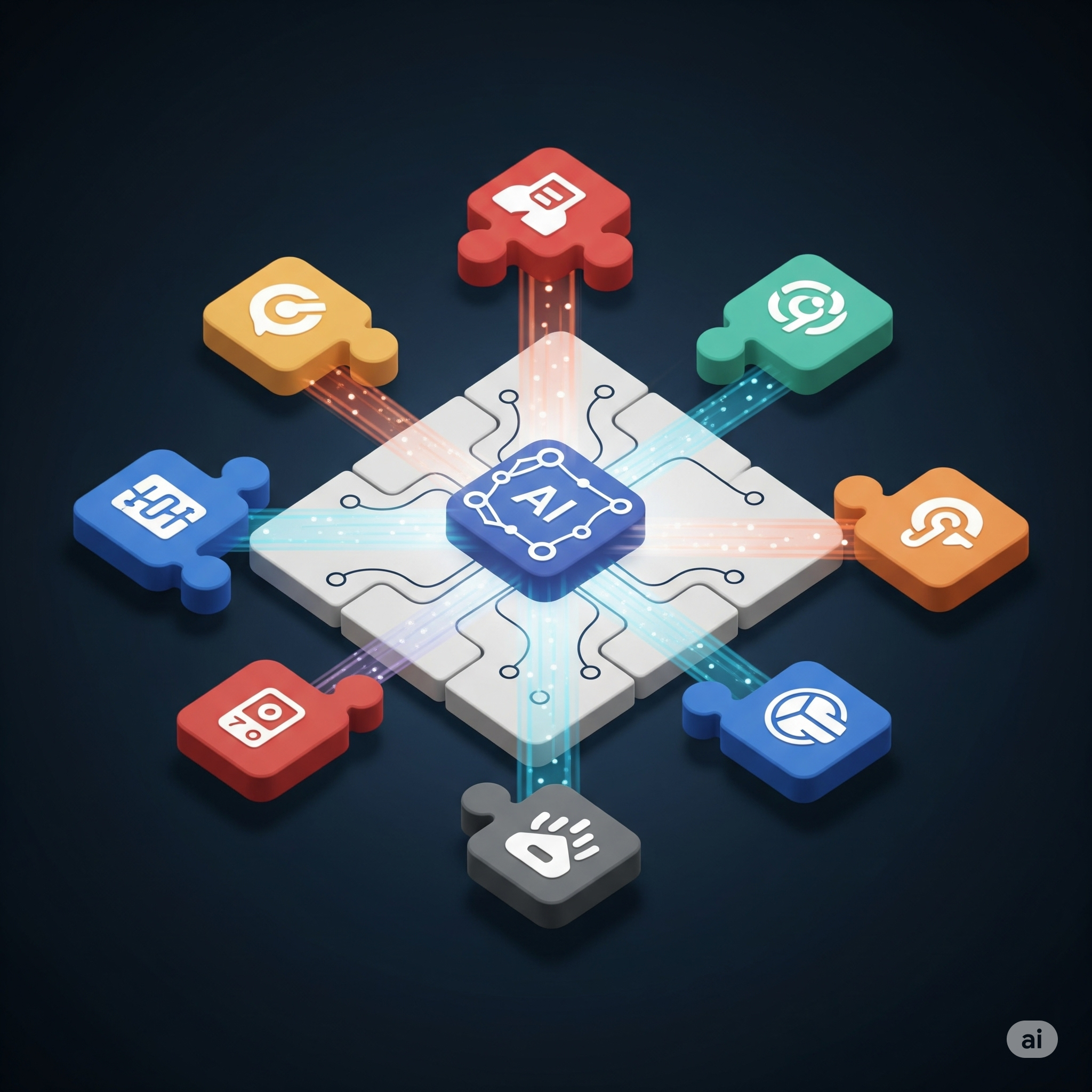May 25, 2025
Why AI Will Not Kill SaaS—It Will Unleash It
How artificial intelligence is about to solve the biggest problem in enterprise software
Picture this: Your company just spent eighteen months and a lot of money implementing a new ERP system. The consultants have finally left. Your team has been trained. Everything should be running smoothly. Instead, you are watching your sales team create complex workarounds in spreadsheets because the CRM does not quite capture how your unique sales process actually works.
Does this sound familiar? You are not alone. This situation happens in companies all over the world. It is one of the most expensive and persistent challenges in modern business technology.

The Great Software Compromise

For decades, businesses have had to make a difficult choice when adopting enterprise software. On one side, there is the promise of powerful, feature-rich platforms like Salesforce, SAP, or Oracle. These systems can theoretically handle everything from customer relationships to supply chain management. On the other side, there is the reality that your business does not operate exactly like every other business.
This is what we call the “software compromise.” Software as a Service (SaaS) platforms are built to serve the common needs of thousands of companies across different industries.
But your business has its own language, its own processes, and its own way of connecting with customers. When you try to fit these unique elements into a standardized system, something has to give.
The result is expensive customizations, complex integrations, and often a fundamental change in how your business operates to match how your software thinks you should operate. It is like buying a suit off the rack and then paying more for alterations than the original suit cost.
The Hidden Costs of Conformity
Let’s look at what this compromise actually costs businesses:
- Process Disruption: Teams are forced to abandon workflows that have been refined over years, sometimes decades. The institutional knowledge embedded in these processes—the subtle adaptations that made your company competitive—gets lost in translation.
- Integration Complexity: When standard software does not quite fit, companies add more tools, creating a complex web of integrations. Each integration point becomes a potential failure point, requiring ongoing maintenance and specialized knowledge.

- Consultant Dependency: The gap between what the software does and what your business needs is filled by expensive consultants who understand both your business and the software. These specialists become critical dependencies, and their knowledge often leaves when the project ends.
- User Resistance: When systems do not match how people actually work, adoption suffers. Users create “shadow systems”—those spreadsheets and workarounds that defeat the purpose of having integrated software in the first place.
Enter AI: The Great Equalizer

Here is where the common thinking gets it wrong. Many people predict that AI will reduce the need for software developers and shrink the software industry. The logic seems simple: if AI can automate coding, we will need fewer developers and less custom software.
But this prediction misses a fundamental change that is already happening.
AI is not just making developers more productive. It is making software development itself more accessible.
What once required large teams and big budgets can now be done by small, focused teams using AI-powered development tools.
Think about what this means for the software compromise. Instead of forcing your business processes into a one-size-fits-all solution, you can now create software that adapts to your business. The price will be low enough that this is a viable option for many more projects.
The Custom Software Renaissance
We are entering a time when the economics of custom software development are being completely rewritten. Here is how AI is changing the game:
- Rapid Prototyping: AI-assisted development allows teams to quickly build and iterate on custom solutions. What used to take months of development can now be done in weeks or even days.
- Lower Technical Barriers: AI coding assistants are making it possible for smaller teams to take on complex projects.

The specialized knowledge needed to build enterprise-grade software is becoming more accessible.
- Intelligent Integration: AI does not just help build new systems. It is great at connecting existing ones. Instead of complex, brittle integrations, AI can create intelligent middleware that adapts to changes in the connected systems.
- Domain-Specific Solutions: With lower development costs, it becomes economically viable to create software for very specific use cases. Your industry’s unique challenges can finally have purpose-built solutions.
The New SaaS Landscape: From One-Size-Fits-All to Perfect-Fit Solutions
Here is where the real change happens, and it is not what most people expect.

Custom development still has costs. Even with AI assistance, building truly custom software requires time, expertise, and ongoing maintenance. But here is the key insight: AI does not just make custom development cheaper. It makes hyper-specialized SaaS economically viable.
Instead of fewer SaaS companies, we are about to see an explosion of what I call “Niche SaaS” or “SaaS-for-Y”—Software as a Service designed for Your specific problem, Your industry, Your exact business model. What do you think? SaaSY or microSaaS? Vote in the comments.
- The Economics of Hyper-Specialization: When development costs drop dramatically, it suddenly becomes profitable to build SaaS solutions for markets that were previously too small. A SaaS platform specifically for orthodontist offices with 3-5 locations? Now it is economically viable. Project management software designed exclusively for film post-production teams? Now it makes business sense.
- Consolidation Through Specialization: Instead of everyone building custom solutions from scratch, businesses will move toward these highly specialized SaaS platforms that feel custom-built for their exact needs. Why spend months developing a custom solution when there is already a SaaS platform that speaks your industry’s language and handles your specific workflows?
- The Long Tail Goes SaaS: Markets that were too niche for traditional SaaS development—those long-tail business needs that required expensive custom solutions—suddenly have their own dedicated platforms. This creates a paradox: more software options lead to more standardization within micro-niches.
- Rapid Platform Evolution: These specialized platforms can evolve quickly based on user feedback from their focused customer base. When your entire user base has similar challenges, feature development becomes very focused and highly relevant.
What This Means for Business Leaders
For executives and technical leaders, this shift represents a fundamental change in software strategy:
- The SaaS Explosion: Prepare for a marketplace with many more software options. The challenge will not be finding software that does what you need. It will be finding the platform that fits your specific business model among hundreds of highly specialized options. And if none fit your exact needs, the cost of building your own is much more affordable.
- Evaluation Complexity: With more niche options available, software selection becomes both easier and harder. It is easier because solutions will fit better. It is harder because there will be so many specialized options to evaluate.
- Competitive Differentiation: Your competitive advantage may increasingly come from identifying and adopting the right niche SaaS platforms before your competitors do.

The businesses that can quickly identify and implement highly specialized solutions will move faster than those stuck with general-purpose platforms.
- Budget Reallocation: Instead of spending on expensive customizations and integrations, budgets will shift toward subscribing to multiple specialized platforms and the tools needed to connect them intelligently.

The Integration Advantage

One often-overlooked benefit of AI-powered development is its superior integration capabilities. AI is great at understanding and translating between different data formats, APIs, and business logic. This means:
- Easier connections between existing systems
- More intelligent data synchronization
- Adaptive integrations that can handle changes in connected systems
- Reduced maintenance overhead for complex system architectures
- The ability to take many smaller SaaSY products or micro SaaS and combine them into a custom solution
This lets businesses combine specialized tools to create custom solutions that they can easily modify as their needs change.
Better yet, AI-powered integration tools will act as the connective tissue between these specialized platforms, creating seamless workflows that were previously impossible. The days of clunky middleware and brittle point-to-point connections are coming to an end. What will emerge is a more flexible, adaptable software ecosystem that can truly conform to how businesses operate. Think MCP and A2A, and the other platforms and standards that will arise to meet this challenge.
Beyond the Death of SaaS: The Great Multiplication
The idea that AI will kill SaaS is a fundamental misunderstanding of what is happening. AI will not reduce the number of SaaS companies. It will multiply them exponentially. You will be able to mix and match much more easily, as well as build and integrate your own custom processes much more easily.

We are moving from a world of dozens of horizontal platforms serving millions of users to a world of thousands of vertical platforms serving thousands of users each. Every industry, every business model, every workflow that currently requires painful customization will eventually have its own purpose-built SaaS platform.

This is not the death of SaaS. It is SaaS finding its true form. Instead of forcing millions of businesses to adapt to a few platforms, we will have platforms that adapt to specific business types. We can morph the software to our business and keep our competitive edge.
- The New Build vs. Buy Equation: The question changes from “Should we customize this platform or build our own?” to “Should we subscribe to the niche platform built specifically for businesses like ours, or try to make do with something more general?”
- Platform Proliferation: Where today you might evaluate 5-10 CRM options, tomorrow you might choose between 50+ CRM platforms designed for specific industries, company sizes, and business models.
- Standardization Through Specialization: Paradoxically, this explosion of options will lead to better standardization within niches. When a platform is built specifically for orthodontist offices, everyone using it follows very similar workflows. No more forcing square pegs into round holes.
The Path Forward
For business and technical leaders, the implications are clear:
- Start experimenting with AI-powered development tools now. The organizations that learn to use these capabilities early will have a significant advantage as the landscape shifts.
- Revisit your current software stack with fresh eyes. Which systems force the most compromise? Which processes have been bent to fit software constraints? These are your prime candidates for AI-enabled custom solutions.
- Begin building internal capabilities around AI-assisted development. This does not necessarily mean hiring armies of developers. It means developing the organizational knowledge to work effectively with AI development tools.
Conclusion: The Unleashing
We are on the verge of a software revolution. AI is not going to kill SaaS. It is going to unleash it from the constraints that have limited its potential for decades.
The future belongs to organizations that can move beyond the software compromise. They will embrace tools that adapt to their business rather than forcing their business to adapt to their tools.
The question is not whether AI will change enterprise software. The question is whether your organization will be among the first to capitalize on this change or among the last to adapt to it.
The era of software that truly serves your business, rather than the other way around, is just beginning.
This transformation is already happening. Companies that adopt AI-powered development and niche, highly specialized SaaS solutions will lead the way. Success depends on how quickly you adapt to these changes.
About the Author
Rick Hightower has extensive enterprise experience as a former executive and distinguished engineer at a Fortune 100 company. He specialized in delivering Machine Learning and AI solutions to create intelligent customer experiences. His expertise covers both the theoretical foundations and practical applications of AI technologies.
As a TensorFlow certified professional and graduate of Stanford University’s comprehensive Machine Learning Specialization, Rick combines academic rigor with real-world implementation experience. His training includes mastery of supervised learning techniques, neural networks, and advanced AI concepts, which he has successfully applied to enterprise-scale solutions.
With a deep understanding of both the business and technical aspects of AI implementation, Rick bridges the gap between theoretical machine learning concepts and practical business applications. He helps organizations use AI to create tangible value.


Apache Spark Training
Kafka Tutorial
Akka Consulting
Cassandra Training
AWS Cassandra Database Support
Kafka Support Pricing
Cassandra Database Support Pricing
Non-stop Cassandra
Watchdog
Advantages of using Cloudurable™
Cassandra Consulting
Cloudurable™| Guide to AWS Cassandra Deploy
Cloudurable™| AWS Cassandra Guidelines and Notes
Free guide to deploying Cassandra on AWS
Kafka Training
Kafka Consulting
DynamoDB Training
DynamoDB Consulting
Kinesis Training
Kinesis Consulting
Kafka Tutorial PDF
Kubernetes Security Training
Redis Consulting
Redis Training
ElasticSearch / ELK Consulting
ElasticSearch Training
InfluxDB/TICK Training TICK Consulting

